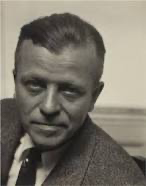Arthur G. Dove
American, (1880–1946)
Arthur Dove, one of the pioneering abstract painters of the early twentieth century, graduated from Cornell in 1903 and worked for a period as a magazine illustrator. His discovery, in Paris in 1908, of Matisse, the Fauves, and the Cubists, as well as his encounter with aesthetic theories that stressed spiritual expression, had a crucial effect on his subsequent work. He spent much of his year abroad in southern France with Alfred Maurer, who provided Dove’s introduction to his lifelong friend and dealer, Alfred Stieglitz. Dove was part of a small circle of artists in New York City, including Alfred Stieglitz and Georgia O’Keeffe, that introduced modernism to America. Throughout Dove’s work, from the early “Nature Symbolized” series, in which houses, sails, and landscape elements are at times almost unrecognizable, to his later abstractions, Dove translated natural forms, sounds, and musical motifs into powerfully expressive paintings. He did a long series of paintings of sunrises, abstracting natural motifs into shapes in an effort to capture the essence of the sun’s energy and its power in the world. The rings in his paintings of sunrises represent light and warmth that emanate from the core of the sun to replace darkness and coldness. Although during the 1920s Dove’s sense of humor emerged in a group of witty and formally inventive assemblages, his watercolors of the 1930s and 1940s, in which he wove imagery “into a sequence of formations” analogous to musical harmonies, are among his most distinctive works.
American, (1880–1946)
Arthur Dove, one of the pioneering abstract painters of the early twentieth century, graduated from Cornell in 1903 and worked for a period as a magazine illustrator. His discovery, in Paris in 1908, of Matisse, the Fauves, and the Cubists, as well as his encounter with aesthetic theories that stressed spiritual expression, had a crucial effect on his subsequent work. He spent much of his year abroad in southern France with Alfred Maurer, who provided Dove’s introduction to his lifelong friend and dealer, Alfred Stieglitz. Dove was part of a small circle of artists in New York City, including Alfred Stieglitz and Georgia O’Keeffe, that introduced modernism to America. Throughout Dove’s work, from the early “Nature Symbolized” series, in which houses, sails, and landscape elements are at times almost unrecognizable, to his later abstractions, Dove translated natural forms, sounds, and musical motifs into powerfully expressive paintings. He did a long series of paintings of sunrises, abstracting natural motifs into shapes in an effort to capture the essence of the sun’s energy and its power in the world. The rings in his paintings of sunrises represent light and warmth that emanate from the core of the sun to replace darkness and coldness. Although during the 1920s Dove’s sense of humor emerged in a group of witty and formally inventive assemblages, his watercolors of the 1930s and 1940s, in which he wove imagery “into a sequence of formations” analogous to musical harmonies, are among his most distinctive works.
Artist Objects
Sunrise IV 1981.052


